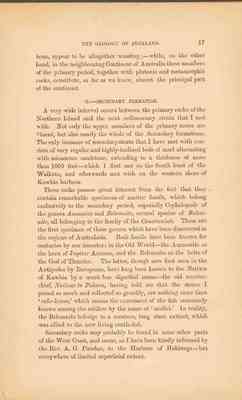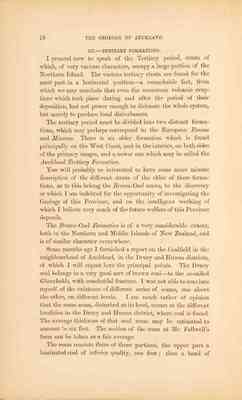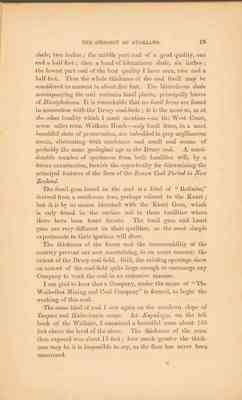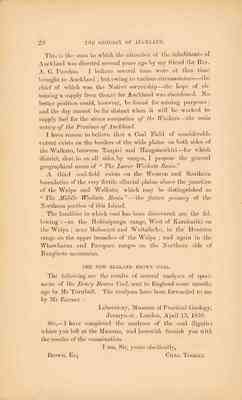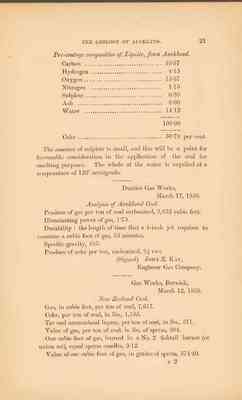Pages
THE GEOLOGY OF AUCKLAND. 17
tems, appear to be altogether wanting; - while, on the other hand, in the neighbouring Continent of Australia these members of the primary period, together with plutonic and metamorphic rocks, constitute, so far as we know, almost the principal part of the continet.
II. - SECONARY FORMATION.
A very wide interval occurs between the primary rocks of the Northern Island and the next sedimentary strata that I met with. Not only the upper members of the primary series are absent, but also nearly the whole of the Secondary formations. The only instance of secondary strata that I have met with consists of very regular and highly-inclined beds of marl alternating with micaceous sandstone, extending to a thickness of more than 1000 feet - which I first saw on the South head of the Waikato, and afterwards met with on the western shore of Kawhia harbour.
These rocks possess great interest from the fact that they contain remarkable specimens of marine fossils, which belong exclusively to the secondary period, especially Cephalopods of the genera Ammonite and Belemnite, several species of Belemnite, all belonging to the family of the Canaticulati. These are the first specimens of those genera which have been discovered in the regions of Australasia. Both fossils have been known for centuries by our ancestors in the Old World - the Ammonite as the horn of Jupiter Ammon, and the Belemnite as the bolts of the God of Thunder. The latter, though now first seen in the Antipodes by Europeans, have long been known to the Natives of Kawhia by a much less dignified name - the old warriorchief, Nuitone te Pakaru, having told me that the stones I prized so much and collected so greedily, are nothing more than 'roke-kanæ,' which means the excrement of the fish commonly known among the settlers by the name of 'mullet.' In reality, the Belemnite belongs to a creature, long since extinct, which was allied to the now living cuttle-fish.
Secondary rocks may probably be found in some other parts of the West Coast, and occur, as I have been kindly informed by the Rev. A.G. Purchas, in the Harbour of Hokianga - but everywhere of limited superficial extent.
18 THE GEOLOGY OF AUCKLAND.
III. - TERTIARY FORMATIONS.
I proceed now to speak of the Tertiary period, strata of which, of very various characters, occupy a large portion of the Northern Island. The various tertiary strata are found for the most part in a horizontal position - a remarkable fact, from which we may conclude that even the numerous volcanic eruptions which took place during and after the period of their deposition, had not power enough to dislocate the whole system, but merely to produce local disturbances.
The tertiary period must be divided into two distinct formations, which may perhaps correspond to the European Eocene and Miocene. There is an older formation which is found principally on the West Coast, and in the interior, on both sides of the primary ranges, and a newer one which may be called the Auckland Tertiary Formation.
You will probably be interested to have some more minute description of the different strata of the older of these formations, as to this belong the Brown-Coal seams, to the discovery of which I am indebted for the opportunity of investigating the Geology of this Province, and on the intelligent working of which I believe very much of the future welfare of this Province depends.
The Brown-Coal Formation is of a very considerable extent, both in the Northern and Middle Islands of New Zealand, and is of similar character everywhere.
Some months ago I furnished a report on the Coalfield in the neighbourhood of Auckland, in the Drury and Hunua districts, of which I will repeat here the principal points. The Drury coal belongs to a very good sort of brown coal - the the so-called Glanzkohle, with conchoidal fracture. I was not able to convince myself of the existence of different series of seams, one above the other, on different levels. I am much rather of opinion that the same seam, disturbed at its level, occurs at the different localities in the Drury and Hunua district, where coal is found. The average thickness of that coal seam may be estimated to amount to six feet. The section of the seam at Mr Fallwell's farm can be taken as a fair average.
The seam consists there of three portions, the upper part a laminated coal of inferior quality, one foot; then a band of
THE GEOLOGY OF AUCKLAND. 19
shale, two inches; the middle part coal of a good quality, one and a half feet; then a band of bituminous shale, six inches; the lowest part coal of the best quality I have seen, two and a half feet. Thus the whole thickness of the coal itself may be considered to amount to about five feet. The bituminous shale accompanying the coal contains fossil plants, principally leaves of Dicotyledones. It is remarkable that no fossil ferns are found in connection with the Drury coal-beds; it is the more so, as at the other locality which I must mention - on the West Coast, seven miles from Waikato Heads - only fossil ferns, in a most beautiful state of preservation, are imbedded in gray argillacious strata, alternating with sandstone and small coal seams of probably the same geological age as the Drury coal. A considerable number of specimens from both localities will, by a future examination, furnish the opportunity for determining the principal features of the flora of the Brown Coal Period in New Zealand.
The fossil gum found in the coal is a kind of "Retinite," derived from a coniferous tree, perhaps related to the Kauri; but it is by no means identical with the Kauri Gum, which is only found in the surface soil in those localities where there have been kauri forests. The fossil gum and kauri gum are very different in their qualities, as the most simple experiments in their ignition will show.
The thickness of the forest and the inaccessability of the country prevent our now ascertaining, in an exact manner, the extent of the Drury coal-field. Still, the existing openings show an extent of the coal-field quite large enough to encourage any Company to work the coal in an extensive manner.
I am glad to hear that a Company, under the name of "The Waihoihoi Mining and Coal Company" is formed, to begin the working of this coal.
The same kind of coal I saw again on the northern slope of Taupiri and Hakarimata range. At Kupakupa, on the left bank of the Waikato, I examined a beautiful seam about 150 feet above the level of the river. The thickness of the seam then exposed was about 15 feet; how much greater the thickness may be it is impossible to say, as the floor has never been uncovered. C
20 THE GEOLOGY OF AUCKLAND.
This is the seam to which the attention of the inhabitants of Auckland was directed several years aog by my friend the Rev. A.G. Purchas. I believe several tons were at that time brought to Auckland; but owing to various circumstances - the chief of which was the Native ownership - the hope of obtaining a supply from thence for Auckland was abandoned. No better position could, however, be found for mining purposes; and the day cannot be far distant when it will be worked to supply fuel for the steam navigation of the Waikato - the main artery of the Province of Auckland.
I have reason to believe that a Coal Field of considerable extent exists on the borders of the wide plans on both sides of the Waikato, between Taupiri and Mangatawhiri - for which district, shut in on all sides by ranges, I propose the general geographical name of "The Lower Wakato Basin."
A third coal-field exists on the Western and Southern boundaries of the very fertile alluvial plains above the junction of the Waipa and Waikato, which may be distinguished as "The Middle Waikato Basin" - the future granary of the Northern portion of this Island.
The localities in which coal has been discovered are the following:- in the Hohinipanga range, West of Karakariki on the Waipa; near Mohoanui and Waitaiheke, in the Hauturu range on the upper branch of the Waipa; and again in the Whawharua and Parepare ranges on the Northern side of Rangitoto mountains.
THE NEW ZEALAND BROWN COAL.
The following are the results of several analyses of specimens of the Drury Brown Coal, sent to England some months ago by Mr Turnbull. The analyses have been forwarded to me by Mr Farmer:
Laboratory, Museum of Practical Geology, Jermyn-st., London, April 13, 1859. Sir, - I have completed the analyses of the coal (lignite) which you left at the Museum, and herewith furnish you with the results of the examination. I am, Sir, yours obediently, Brown, Esq Chas. Tookey.
THE GEOLOGY OF AUCKLAND. 21
Per-centage composition of Lignite, from Auckland. Carbon ............................................ 55.57 Hydrogen ........................................ 4.13 Oxygen ............................................ 15.67 Nitrogen .......................................... 1.15 Sulphur ........................................... 0.36 Ash .................................................. 9.00 Water ............................................... 14.12 _____ 100.00 ______ Coke ............................................... 50.78 per cent
The amount of sulphur is small, and this will be a point for favourable consideration in the application of the coal for smelting purposes. The whole of the water is expelled at a temperature of 120⁰ centigrade __________________ Dundee Gas Works, March 17, 1859. Analysis of Auckland Coal. Produce of gas per ton of coal carbonized, 9,632 cubic feet. Illuminating power of gas, 1∙75. Durability: the length of time that a 4-inch jet requires to consume a cubic foot of gas, 53 minutes. Specific gravity, 495. Produce of coke per ton, carbonized, 9¼ cwt. (Signed) JOHN Z. KAY, Engineer Gas Company. ______________ Gas Works, Berwick, March 12, 1859. New Zealand Coal. Gas, in cubic feet, per ton of coal, 7,617. Coke, per ton of coal, in lbs., 1,155. Tar and ammoniacal liquor, per ton of coal, in lbs., 571. Value of gas, per ton of coal, in lbs. of sperm, 384. One cubic foot of gas, burned in a No. 2 fishtail burner (or nion set), equal sperm candles, 3∙12. Value of one cubic foot of gas, in grains of sperm, 374∙40. C2
